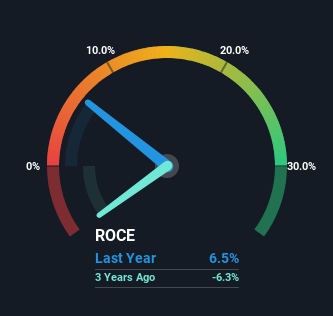What are the early trends we should look for to identify a stock that could multiply in value over the long term? One common approach is to try and find a company with returns on capital employed (ROCE) that are increasing, in conjunction with a growing amount of capital employed. Put simply, these types of businesses are compounding machines, meaning they are continually reinvesting their earnings at ever-higher rates of return. So when we looked at BBR Holdings (S) (SGX:KJ5) and its trend of ROCE, we really liked what we saw.
What Is Return On Capital Employed (ROCE)?
For those who don't know, ROCE is a measure of a company's yearly pre-tax profit (its return), relative to the capital employed in the business. Analysts use this formula to calculate it for BBR Holdings (S):
Return on Capital Employed = Earnings Before Interest and Tax (EBIT) ÷ (Total Assets - Current Liabilities)
0.065 = S$15m ÷ (S$324m - S$97m) (Based on the trailing twelve months to June 2023).
Thus, BBR Holdings (S) has an ROCE of 6.5%. On its own that's a low return, but compared to the average of 3.6% generated by the Construction industry, it's much better.
View our latest analysis for BBR Holdings (S)

Historical performance is a great place to start when researching a stock so above you can see the gauge for BBR Holdings (S)'s ROCE against it's prior returns. If you want to delve into the historical earnings, revenue and cash flow of BBR Holdings (S), check out these free graphs here.
So How Is BBR Holdings (S)'s ROCE Trending?
Shareholders will be relieved that BBR Holdings (S) has broken into profitability. While the business was unprofitable in the past, it's now turned things around and is earning 6.5% on its capital. On top of that, what's interesting is that the amount of capital being employed has remained steady, so the business hasn't needed to put any additional money to work to generate these higher returns. That being said, while an increase in efficiency is no doubt appealing, it'd be helpful to know if the company does have any investment plans going forward. After all, a company can only become a long term multi-bagger if it continually reinvests in itself at high rates of return.
For the record though, there was a noticeable increase in the company's current liabilities over the period, so we would attribute some of the ROCE growth to that. Essentially the business now has suppliers or short-term creditors funding about 30% of its operations, which isn't ideal. It's worth keeping an eye on this because as the percentage of current liabilities to total assets increases, some aspects of risk also increase.
The Bottom Line
As discussed above, BBR Holdings (S) appears to be getting more proficient at generating returns since capital employed has remained flat but earnings (before interest and tax) are up. And since the stock has fallen 36% over the last five years, there might be an opportunity here. That being the case, research into the company's current valuation metrics and future prospects seems fitting.
BBR Holdings (S) does come with some risks though, we found 4 warning signs in our investment analysis, and 1 of those makes us a bit uncomfortable...
While BBR Holdings (S) may not currently earn the highest returns, we've compiled a list of companies that currently earn more than 25% return on equity. Check out this free list here.
Valuation is complex, but we're here to simplify it.
Discover if BBR Holdings (S) might be undervalued or overvalued with our detailed analysis, featuring fair value estimates, potential risks, dividends, insider trades, and its financial condition.
Access Free AnalysisHave feedback on this article? Concerned about the content? Get in touch with us directly. Alternatively, email editorial-team (at) simplywallst.com.
This article by Simply Wall St is general in nature. We provide commentary based on historical data and analyst forecasts only using an unbiased methodology and our articles are not intended to be financial advice. It does not constitute a recommendation to buy or sell any stock, and does not take account of your objectives, or your financial situation. We aim to bring you long-term focused analysis driven by fundamental data. Note that our analysis may not factor in the latest price-sensitive company announcements or qualitative material. Simply Wall St has no position in any stocks mentioned.
About SGX:KJ5
BBR Holdings (S)
An investment holding company, engages in construction business in Singapore, Malaysia, and Thailand.
Excellent balance sheet with low risk.
Market Insights
Community Narratives




